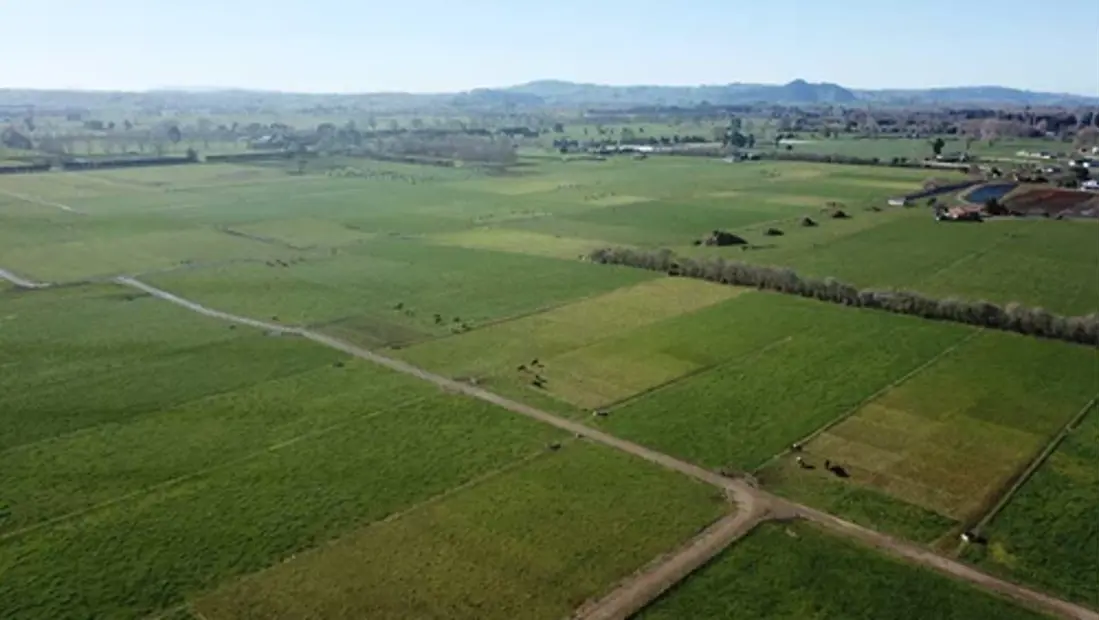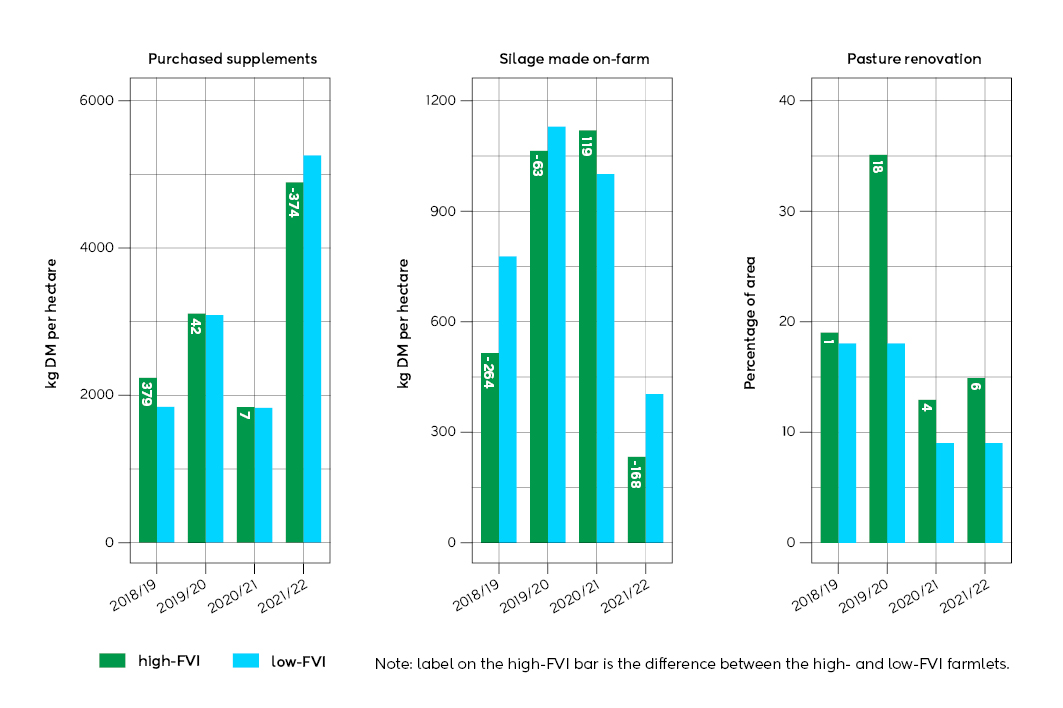Forage Value Index
8 min read
The Forage Value Index (FVI) was designed to help dairy farmers in New Zealand identify the best forages for their farm system by ranking different ryegrass cultivars. The FVI validation trial was established in the Waikato to evaluate the FVI at farmlet scale. The expectation was that higher FVI pastures would produce more dry matter, leading to increased milk production and profit, and lower production costs. Results from the FVI validation trial showed that the economic advantage expected from the higher FVI cultivars selected from ryegrass DM yield measured at the plot scale, was not captured in this single farmlet scale trial.
DairyNZ and the Plant Breeding Research Association (PBRA) are committed to working together to understand the root causes of the FVI validation trial result. Until the predicted economic differences among cultivars listed in the FVI can be demonstrated, FVI economic rankings will not be published.
DairyNZ removed the Cultivar Selector Tool on the 19th of March 2024.
Further information is provided to support your decisions on the cultivar selection page.
In 2012, the Forage Value Index (FVI) was launched in partnership with the Plant Breeding and Research Association (PBRA). The FVI categorises perennial and short-term ryegrass cultivars into five star ranking groups across the four dairy regions: upper and lower North Island, and upper and lower South Island. Those with a higher star rating were predicted to deliver greater economic benefits for dairy farmers.
Key components
The two key components required to calculate the FVI of a cultivar are:
Sitting behind these components are two key assumptions:
Since 2012, other traits, such as metabolisable energy (ME), and persistence, have been included.

The Forage Value Index validation trial was run to determine if predicted differences in forage value were reflected in pasture grown, milk production and profit (all measured on a per-hectare basis) when cultivars with different FVI rankings were compared in self-contained production systems.
Before the validation experiment began, data from previous DairyNZ small plot trials was modelled using Farmax to develop the predicted outcomes. The Forage Value Index validation trial was designed to detect a $300-400/ha difference between treatments, as the DairyNZ FVI modelling predicted.
The predicted difference in profit would be from greater daily production and lower production costs, explained by:
Dry matter yield
Supplementary feeds
Milk production

In 2015, a farmlet-system comparison trial was designed to validate the FVI rankings under realistic farm management conditions on DairyNZ’s Scott farm in the Waikato.
Location:
Hamilton
Farm size:
40ha
Treatments:
Five higher FVI farmlets, fiver lower FVI farmlets
Cultivars:
Diploids, sown individually with white clover
Endophyte:
AR37
Stocking rate:
3.5 cows/effective ha
Nitrogen:
Around 180 kg/ha annually
Purchased feed:
Only offered in a pasture deficit
Sowing of pastures began in 2016, with five farmlets containing higher FVI (4- and 5-star) cultivars, and five farmlets with lower FVI (1- and 2-star) cultivars chosen from the 2015 FVI lists. All cultivars were diploid perennial ryegrasses and were sown individually with white clover.
Endophyte
The endophyte AR37 was chosen due to the location of the trial in the Upper North Island, meaning an endophyte that provided greater protection against damage from insects such as Black Beetle was required. The choice of a single endophyte meant that the low-yielding cultivars with other endophytes were not considered. Designing the trial this way meant that we could test the yield benefits of higher FVI cultivars without any confounding effects of endophyte or ploidy.
Trial management
The trial was managed under the same conditions for the first three years, stocking rate, herd replacement rate and planned start of calving were kept the same for the higher and lower FVI treatments. Several management changes were implemented in the fourth year, including calving one week earlier and different winter rotation lengths between higher and lower FVI treatments.
Data collection and measurements
Between 2018 and 2022, data on farmlet performance (animals, pasture and feed) was collected to determine the physical and financial benefits of the higher and lower FVI cultivars. Poor-performing pastures in both treatments were renovated (full or partial) as required to maintain the plant population.
Pasture measurements included dry matter yields, pasture composition and feed quality. Milk production of cows was measured, as well as cow body condition score. Feed measurements included silage harvested and imported supplementary feed.
Industry collaboration
To ensure the trial was robust, representatives from the PBRA along with national and international science experts were involved in the planning and implementation phases. Four Waikato dairy farmers regularly engaged with the project to ensure tactical and strategic management decisions (e.g., shortening winter round lengths) aligned with best practices on-farm.
Profit
During the first three seasons, milk production and revenue were similar for all farmlets. However, the higher FVI farmlets incurred more costs than predicted for purchased supplementary feed, silage harvesting and pasture renovation.
Only in the last season (2021/22), with similar milksolids production and less expenses, did the higher FVI farmlets return a positive margin (+$73/ha). This was still lower than predicted. The positive marginal return from the higher FVI farmlets in 2021/22 indicates that the change in management may have suited the performance of these cultivars.
The relative differences in profit (calculated from milk revenue less costs associated with supplementary feed and silage making, and pasture renovation), for farmlets with higher FVI pastures compared with lower FVI pastures are presented below. No significant difference was detected between treatments in any year.
| Year | Advantage to higher FVI treatment | Standard Error of the Differences (SED) |
| 2018-2019 | -$192 | 107 |
| 2019-2020 | -$36 | 269 |
| 2020-2021 | -$219 | 202 |
| 2021-2022 | $73 | 145 |
We predicted there’d be better alignment between pasture supply and demand in farmlets using higher FVI cultivars, resulting in less demand for purchased supplementary feed (-500kg DM/ha) and less need to harvest silage (-600kg DM/ha).
Purchased supplements
For the first three seasons, more supplementary feed was purchased in higher than lower FVI farmlets. In 2021/22, less supplementary feed was purchased in higher FVI farmlets, potentially because pasture management targets were changed in the last season.
Silage made on-farm
The differences in silage harvested between farmlets with higher or lower FVI cultivars were less than predicted, and in 2020/21, more silage was harvested from higher FVI farmlets. This was because greater pasture renovation in farmlets with higher FVI cultivars in autumn 2020 resulted in nitrate toxicity levels preventing spring grazing.
Pasture renovation
Throughout the four-year trial, 71% of the higher FVI and 49% of the lower FVI area required pasture renovation (undersowing).
The graph shows the difference between higher and lower cultivars for purchased supplements, silage made on-farm, and pasture renovation over four years.

Note: the label on the high-FVI bar is the difference between the higher and lower FVI farmlets.
Milk production
Our prediction of more days in milk for cows in the higher FVI farmlets assumed there’d be more pasture available in autumn on those farmlets. However, dry conditions in all four years of the trial meant cows were dried off at similar times in both the higher and lower FVI farmlets.
In the first three seasons during peak lactation, milksolids production for cows grazing both higher and lower FVI cultivars was less than predicted.
Over the four seasons, there was no significant difference in whole-season milksolids production between higher and lower FVI cultivar farmlets.
To understand why the relative difference in profit differed from predictions, an in-depth review of farmlet performance was undertaken by DairyNZ and several areas were explored. Some of these results from this investigation are covered here.
Summer-autumn dry
In all four years, the growth rates in January-March were low due to warmer and drier-than-average summers and autumns. The maximum daily temperatures exceeded 25oC for 73 days each year, compared with 28 days per year for the preceding 30-year period. Rainfall in January and February was approximately 50% of the 30-year average.
This reduced the opportunity for the late-heading, higher FVI cultivars, bred for superior summer-autumn growth, to achieve their potential. With a pasture deficit for all farmlets in autumn each year, cows in all farmlets were dried off at a similar time. Thus, the predicted extra milksolids production from more days in milk and the subsequent milk revenue for the higher FVI farmlets did not occur.
To determine if the dry autumn weather was the primary cause of the less-than-predicted profit, we re-ran the FVI model, reducing the value of autumn pasture to reflect the dry conditions. The predicted profit difference between treatments was only reduced by 25%. This indicated that the dry autumn conditions and lack of autumn pasture growth were important factors but did not fully account for the less-than-predicted profit difference in the higher FVI treatment.
Pasture growth
While autumns were dry, conditions for ryegrass growth were good in winter and early spring. These were seasons when the yield advantage was expected to favour the higher FVI treatment, and this did not happen.
Cultivar choice
Continued improvement in ryegrass over the past eight years means that there are now higher ranked cultivars on the FVI than were available when the FVIV trial was established. The higher FVI cultivars used in the trial are ranked 3-Star in the 2023 FVI. An analysis using the 2023 FVI values indicated the predicted performance gap between the higher and lower FVI cultivars selected in 2015 and used in the trial remained greater than $300-400/ha.
DairyNZ ran a four-year farm systems trial at Scott Farm in the Waikato, looking to validate the FVI through differences in dry matter (DM) yield, milk production, and farm profitability between higher and lower FVI diploid ryegrass cultivars with the same AR37 endophyte. The DairyNZ FVI modelling projected a $300-$400/ha difference between treatments. The results of the validation trial showed that the predicted milksolids production and operating profit expected from ryegrass dry matter yield measured at the plot scale was not able to be captured in this single farmlet scale trial.
Now’s the perfect time to check in, plan, and set up for a strong season. We’ve pulled together smart tips and tools to help you stay ahead all winter long.
Whether you prefer to read, listen, or download handy guides, we’ve got you covered with trusted tools to support your journey every step of the way.
Put our proven strategies and seasonal tools to work. Boost production, support animal health and watch your profits hum.
Tools that are backed by science, shaped by farmers and made for this season.
That’s Summer Smarts.